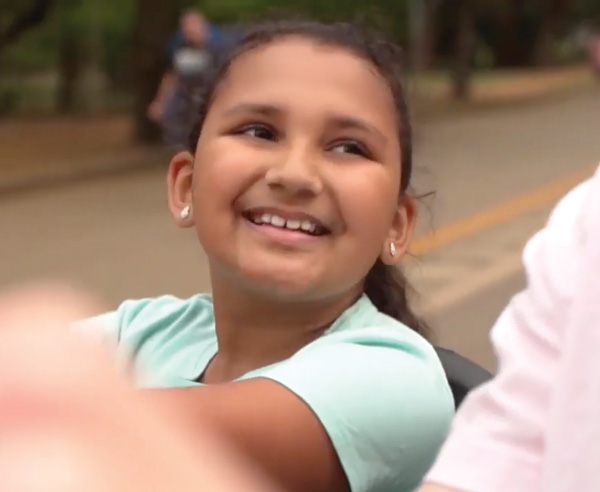Campus Digest
Happenings from around Boston College.
Eric Williamson photographed outside the Dana-Farber Cancer Institute in Boston.
Photo: Lee Pellegrini
Nearly seven years ago, Eric Williamson LGSOE’24 stopped at a table staffed by fellow Loyola University Chicago students who were looking for bone marrow donations—and because he did, a little girl in Brazil is in remission from leukemia today.
Williamson, then a senior at Loyola, wandered by a table for the “Delete Blood Cancer” campaign by DKMS, an international nonprofit dedicated to the fight against blood cancer and blood disorders. The promotional material characterized the chances of a bone marrow match as low, but noted that the potential impact on a recipient could be life-saving.
“I was curious, and after learning the risk on my part was very small, I felt there was no reason for me not to sign up,” recalled the Dallas native, now a doctoral student in the Measurement, Evaluation, Statistics, and Assessment department at the Lynch School of Education and Human Development.
Williamson agreed to a cheek swab, which resulted in the addition of his DNA into a worldwide registry—and so began the chain of events that would bring him into the lives of a young girl named Thaiza, from São Paolo, and her parents.
Bone marrow is the soft, spongy tissue in most bones that produces white blood cells to fight infections, red blood cells to carry oxygen throughout the body, and platelets to stop bleeding. The transplanted marrow replaces tissue damaged or destroyed by disease, infection, or high-dose chemotherapy. According to DKMS, approximately 70 percent of all patients who need a bone marrow transplant must find a compatible donor outside of their family.
What were the chances that the tall male Texan would be a genetic match with a little Brazilian girl?
“The lion’s share of our genes are very similar or nearly identical between humans,” explained Boston College Biology Professor and Chair Welkin Johnson. Among the few exceptions are the human leukocyte antigens (HLA), which are proteins or markers on most cells in the body. The immune system uses HLA to recognize which cells belong in your body and which do not.
“Even siblings can have very different HLA genes, which is why the search for donors involves casting a very wide net to increase the chances of finding a match,” Johnson said. “A close HLA match— meaning that the donor’s and recipient’s tissues are more likely to be immunologically compatible—increases the chance that the patient’s body will accept donated cells as its own and not fight them.”
Following graduation from Loyola, Williamson joined AmeriCorps, the national voluntary civil service program, and moved to Boston to teach at a charter school. But in April 2015, he received a surprising message: His bone marrow matched a cancer patient in need of a transplant. Would he be willing to donate?

Thaiza, the girl in Brazil who received Williamson’s bone marrow. Video Still: Globo/Fantastico
After consulting a surgeon and previous donors at Boston’s Dana-Farber Cancer Institute, Williamson underwent the two-hour procedure in July of that year. He spent a week at home recuperating.
“The worst side effect of the surgery was just some soreness where they withdrew the marrow,” he said. “Giving up one week of time was nothing compared to the potential benefit for the recipient.”
Meanwhile, Williamson’s bone marrow was headed to Brazil, where Thaiza—already a survivor of bone cancer—was undergoing treatment for cancer of her body’s blood-forming tissues at Grupo de Apoio a Crianças e Adolescentes com Câncer (GRAACC), an oncology hospital and social-service institution affiliated with the Federal University of São Paulo. GRAACC treats as many as 3,500 children and adolescents with cancer throughout Brazil each year.
Nearly eighteen months after Williamson’s surgery, his bone marrow was transfused into Thaiza, giving her a lifeline and a chance for remission, with success rates running as high as 80 percent.
Now ten years old, she leads a normal life without restrictions, and returns to GRAACC for regular checkups.
“Eric is a gift from God to our family,” said Thaiza’s father, Chicao. “He was chosen by God to save her life. He said ‘yes’ simply to be good to his neighbor. We will always be grateful to him for such a noble gesture.”
Williamson is “the blood brother she doesn’t have,” Chicao added.
Last September, Williamson received a second, extraordinary surprise: a five-day visit to São Paulo, arranged and underwritten by GRAACC, so he could meet Thaiza and her family. A video crew captured the entire trip, including the emotional rendezvous between donor and recipient. “Meeting Thaiza changed my life,” Williamson said. “I’ll always hold in my heart the memory of the first time we saw each other, and the overwhelming feeling of being loved that came from—literally—dozens of hugs from her parents, aunts and uncles, grandparents, cousins, and close friends. I felt such overwhelming joy from an entire extended family I didn’t realize I had, all because over seven years ago I happened to stop at a table and swab my cheek.”
The feeling is mutual, Chicao said. “We loved meeting him, and now he is part of our family.” ◽
To learn more about donating bone marrow, which can be done more than once, go to dkms.org, or call 212-209-6700.